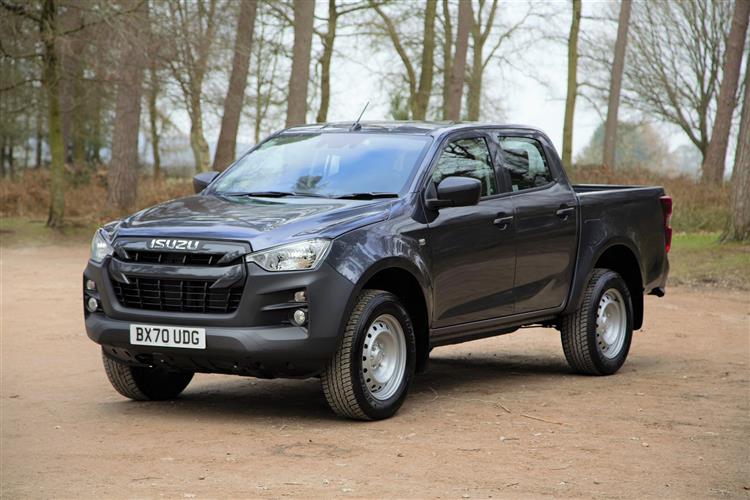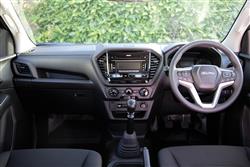EVEN MORE D-PENDABLE (some text hidden) SECTIONED_new_isuzud-max_2021
By Jonathan Crouch
Introductionword count: 102
If you thought Isuzu pick-ups were a bit rough and ready, it's probably about time you gave the D-Max a try. Once, this brand was really one reserved for the requirements of pure commercial operators. In this rejuvenated 'RG'-series form though, the D-Max will also suit private buyers looking for an all-terrain utility vehicle that can play the lifestyle card, thanks to sharper looks, a smarter cabin and better drive dynamics. But it's still as tough as ever - which is why so many professionals choose this Isuzu. In a marketplace full of pretenders, it's that rarest of things: the genuine article.
Modelsword count: 3
1.9 Pick-up (diesel)
Historyword count: 396
Once upon a time, almost every mainstream brand made a pick-up. These days though, what our US and Australian neighbours call 'trucks' or 'utes' are made only by brands really serious about this sector. And here's one of them, Isuzu, who in 2021 brought us this completely rejuvenated second generation 'RG'-series version of their contender in this segment, the D-Max. Isuzu's been selling pick-ups here since the original TF model's launch back in 1988. Which was followed in 2002 by an 'RA'-series model badged in the UK as 'Rodeo', which was updated with common rail engine tech in 2004. The replacement 'RT'-series design was launched in 2012, at which point this model line gained the 'D-Max' badging that's carried through here. In 2017, the 'RT' version got an engine transplant and facelift - which was before more stringent Euro emissions regulations arrived to almost strangle the segment. Whatever you do to it beneath the bonnet, a pick-up is never going to be particularly efficient and by the end of the century's second decade, a number of car brands in this class found that they could no longer afford to have a truck of this sort dragging down the collective across-the-range efficiency figures on which European emission fines are now based. So the Mercedes X-Class, the Fiat Fullback and the first generation Volkswagen Amarok all left the sector in 2020. Then Nissan announced their Navara model would be following suit, leaving the showrooms around the same time as the Mitsubishi L200, a casualty of that brand's exit from the UK market. Which by 2021 left only the Toyota Hilux, the Ford Ranger and the SsangYong Musso up against this D-Max. This 'RG'-series model, developed in collaboration with Mazda, was launched in Thailand in late 2019 and in other countries was sold with a 'Colorado' badge by Chevrolet and Holden. It took until early 2021 for this particular D-Max to appear here, tasked with disrupting the market dominance of the Ranger and Hilux class leaders. The 1.9-litre diesel engine was carried over from the previous model, as was the tough ladder-framed chassis, but pretty much everything else here was new - including a class-leading level of camera safety and a completely redesigned cabin. The original 'RG' design sold until mid-2023, when it was replaced by a facelifted model. It's the original 2021-2023-era 'RG' D-Maxes we look at here.
What You Getword count: 859
Styling hasn't been a priority for Isuzu pick-ups in the past that offered rugged, squarical shapes, big wheels, lots of chrome - and not a lot else. But that changed a bit with the more arresting 'cage fighter'-style aesthetics of this 'RG'-series design, enough to deliver quite an overtaking statement and a far more powerful pavement stance. Most of the changes took place at the front, where the chunky, high-riding looks were embellished with a more imposing front grille which featured a pair of thick chrome bars across its width. This appendage is flanked by distinctive angled headlights, which featured more sophisticated Bi-LED beams on plusher models, with integrated LED daytime running lights - and LED fog lamps further down. Though most customers will want the Double Cab body style - which is conditional for customers wanting the top 'V-Cross' 'Adventure Range' model - Isuzu also continued to offer an 'Extended Cab' variant alongside it in the more affordable mid-level 'All-Purpose Range' (think 'back-to-front' rear doors and occasional rear seats). In the base 'Business Range', that 'Extended Cab' variant featured along with the traditional Single Cab body shape with its much longer cargo bay. All the bodywork was new for this 'RG' design; the mid-level belt line was 30mm higher, while the body length of this Double Cab variant shrunk by 30mm over the previous D-Max, compensated for by a wheelbase length increase of, you've guessed it, 30mm. Once you're inside, there's quite a difference over the old 'RT' model, driven by customer feedback that told Isuzu in no uncertain terms that a more comfortable cabin was required this time round. There's still the high-set driving position that's typical of a pick-up in this class, but everything else changed considerably. Most notably perhaps, the 'RG' D-Max entered the era of screen tech - there's a 4.2-inch display flanking the analogue dials in the redesigned instrument cluster. And for plusher DL40 and V-Cross models, the centre stack gained a modern touchscreen which will be either 7 or 9-inches in size (depending on spec) and includes 'Apple CarPlay'/'Android Auto' smartphone-mirroring. All-round visibility isn't bad for a pick-up, the seats are far more supportive and there's plenty of cabin storage. What's it like for rear passengers in the Double Cab model? Well there are huge grab handles by both doors to help you haul yourself in. DL40 and V-Cross variants get re-designed and very substantial side steps too. Which you'll need because like most pick-ups, the floor height is rather high. Once inside, there's slightly more passenger comfort than is provided by some rival models, thanks to the increase in wheelbase length, all of which has been used to the benefit of rear-seated folk. There's certainly a little more legroom than there was previously and, as before, there's decent room for head and shoulders. You'll also appreciate the way that the seat back angle was slightly changed to make the backrest less vertically inclined, which gives noticeably greater comfort on longer journeys. One nice touch is the way that twin storage areas under the 60:40-split rear seat base enable you to more flexibly use this rear passenger space for packages, should you so wish. You lift a little flap on each side. Plus you can also pull down the rear seat backrest, preventing the upholstery from getting grubby when you're carrying pets or packages. What about the load bay area? Well if you've used a D-Max in the past, the first thing you'll notice on the 'RG' design is that Isuzu added a damper to the tailgate, so it doesn't fall open as soon as you release it. The thing is still pretty heavy to lift though. A big step has been moulded into the bumper so that reaching in is a little easier; and 30mm of extra depth has been added to the cargo bay compared with the previous 'RT' model - though the resulting 465mm depth figure is still comfortably the least accommodating in the class from this period. The 1,495mm load bay length of the Double Cab model is also bettered in period by the Toyota Hilux (1,525mm), the long wheelbase SsangYong Musso (1,600mm) and the Ford Ranger (1,613mm). Obviously, you'll gain more load bay length with the alternative two D-Max body shapes; the Extended Cab offers 1,805mm and the Single Cab has 2,315mm. As with this Isuzu's three key segment rivals, there's enough load bay width (1,530mm) to take a standard UK-sized pallet lengthways between the wheel arch intrusions. And this area meets the usual pick-up class qualification that it should be able to take over a tonne of weight; with the top Double Cab auto model, the figure is up to 1,070kgs; you'll be able to take a fraction more if you choose a manual gearbox or an Extended Cab model - and the figure for the Single Cab is up at 1,205kgs. In our 'Driving Experience' section, we brief you on this D-Max's class-competitive 3.5-tonned braked towing capacity; but noted the reduction that would be necessary to that figure were the load bay to be fully weighted-up (an issue also with the Ranger and the Hilux).
To see the full road test text contact us on 0330 0020 227
Pictures (high res disabled)

.jpg)
|
.jpg)
|
.jpg)
| |||
.jpg)
|
.jpg)
|
.jpg)
| |||
.jpg)
|
.jpg)
|

|
Scoring (subset of scores)
Category: Pick-Ups
| Performance | |
| Handling | |
| Comfort | |
| Space | |
| Styling, Build, Value, Equipment, Depreciation, Handling, Insurance and Total scores are available with our full data feed. | |



